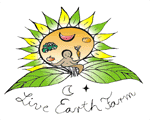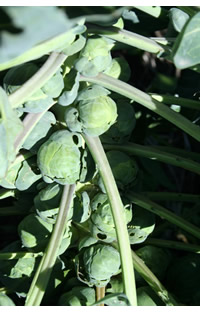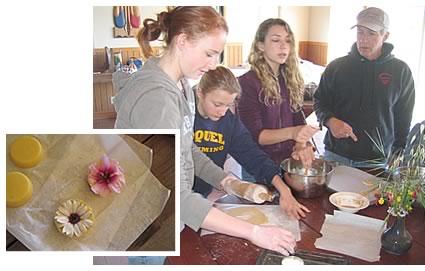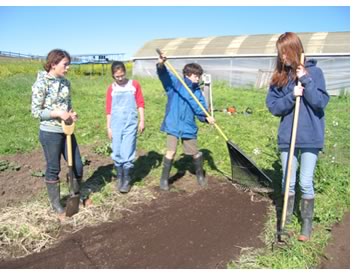
~~~~~~~~~~~~~~~~~~~~~~~~~~~~~~~~~~~~~~~~~~~
Live Earth Farm (Com)Post
7th Harvest Week, Winter 2007/2008
Wednesday February 20th, 2008
~~~~~~~~~~~~~~~~~~~~~~~~~~~~~~~~~~~~~~~~~~~
In this issue
--Greetings from Farmer Tom
--In Search of a Board Member
--Montessori Wavecrest Update
--Live Earth Farm Kids
--What's in the box this week
--Notes from Debbie's Kitchen
--Contact Information
" Many of us who have been pursuing sustainable farming
since before there was a Whole Foods or a National Organic Standards
Board are realizing that the most important aspects of a healthy food
system are relationships – interpersonal, biological, and
ecological. Food shouldn’t be just another fuel, grown out of sight
by anonymous people, prepared and consumed as quickly as possible as
if it were an inconvenience. Growing and eating food are sacred acts;
we need to reclaim them from the scientists and the industrialists, the
bureaucrats and the organicrats. "
~
Michael Ableman, from ‘Fields of Plenty’
Greetings from Farmer Tom
~~~~~~~~~~~~~~~~~~~~~~~~~~~~~~~~~~~~~~~~~~~~~~~~
As a kid, Brussels sprouts did not rank among my top ten most favorite vegetables... probably not even in the top 30. Memories of having to eat these overcooked, mushy, smelly, and often bitter "miniature green cabbages" probably contributed to my bias which had me leaving them off my annual crop plan for all these years. But the number of requests, both by CSA members and farmer's market customers, finally made me decide to experiment and plant four quarter-acre successions for the 2007/2008 winter season. Who says you can't teach an aging farmer (yeah, I am turning 45) new tricks??? This week is our last harvest of Brussels sprouts, which I never expected to last this long – almost three months – and I have become a Brussels sprouts convert. Given their popularity at our markets, among our Winter CSA members, and even in our own kitchen, they have earned their place as one of the farm's staple winter vegetables. Freshly steamed, still with a slight crunch, tossed together with carrots, beets, and rutabagas, seasoned with some olive oil, butter and salt, even my kids have not voiced any resistance!!!
 Brussels sprouts are cool season biennials, which means the first year they spend
most of their energy on vegetative growth (which is of most benefit to us), unless
we grow them for seed. The plant first grows a tall stem (3-4 feet), with an
abundance of round, almost heart-shaped leaves attached to it from the bottom
to the top. At the top of the stem the leaves cluster, forming an umbrella over
the entire plant, the very top of which looks like a small, loose head of cabbage
itself. The harvestable Brussels sprouts develop below though, along the shaft
of the stem, one in each leaf axil.
Brussels sprouts are cool season biennials, which means the first year they spend
most of their energy on vegetative growth (which is of most benefit to us), unless
we grow them for seed. The plant first grows a tall stem (3-4 feet), with an
abundance of round, almost heart-shaped leaves attached to it from the bottom
to the top. At the top of the stem the leaves cluster, forming an umbrella over
the entire plant, the very top of which looks like a small, loose head of cabbage
itself. The harvestable Brussels sprouts develop below though, along the shaft
of the stem, one in each leaf axil.I have to admit it's one of the more challenging crops to grow organically though. Brussels sprouts have a long growing season, over 100 days from transplant to first harvest. This makes them the choice hideaway for green aphids. The abundance of leaves on each plant offers a safe-haven for these soft-bodied insects; this makes them the most challenging to keep under control. To reduce damage in future plantings I will increase the spacing between plants, interplant Sweet Alyssum to attract a larger populations of predatory wasps, as well as release beneficial insects early enough to stay on top of their explosive infestation rate. Once we get our first hard frost, the aphids become less of a problem; also, more importantly, the flavor improves dramatically as plant cells work to convert starches to sugars to protect the plant against the cold. The result is a sweet, fresh tasting delicacy which I hope you all have been enjoying -- or which some of you may, like me, have discovered anew this winter.
As our winter crops start dwindling, we are in full preparation for the spring season, which is probably the most unpredictable of them all. The crab apples, plums and apricots are starting to push their buds and will soon flower. The last couple of weeks of fairly warm and dry weather has been wonderful for helping to get us on track with our plantings. The green house is packed with seedlings, the seed potatoes are starting to break dormancy, and you know Spring is not too far off when strawberries are starting to flower and the first green fruit are showing. The goats' pregnant bellies are a growing reminder of another busy season of milking and feeding our small but steadily expanding herd of "cabritas." Soon the farm will be buzzing once again with a lot of exciting new changes and I look forward to a rich, bountiful and nourishing year to share with all of you.
<back to top>
In Search of a Board Member
~~~~~~~~~~~~~~~~~~~~~~~~~~~~~~~~~~~~~~~~~~~~~~~~
Dear Valued CSA Member Community,
This is Jessica Ridgeway speaking; I am reaching out to you in search of a Board
Member for our fledgling educational nonprofit. As I mentioned in a previous
note to all of you, Tom and Constance hired me to run the farm’s educational
programs. As we expand the educational programs offered at Live Earth Farm,
one of our goals is to establish a nonprofit organization to support these programs. I
have worked long and hard on writing Articles of Incorporation and Bylaws and
the next steps are to create a Board of Directors, have our first meeting and
approve the organization’s bylaws. And so we call to you, our valued
CSA members. Is there one among you who would be interested in joining
the Board of this new nonprofit? Our mission is as follows:
To provide educational programs for the community focused on local, organic,
and sustainable food systems. Live Earth Farm’s educational nonprofit
will offer year round educational programs including but not limited to:
<>Organic farming (produce, fruit, cover cropping, crop rotation, and integrated
pest management);
<>Local food networks;
<>Nutrition;
<>Humane livestock management (chickens and goats);
<>Permaculture design principals
If you are the person to take this place of honor on our first Board of Directors
please contact me:
By phone: (831) 763-2448 [#3
for Jessica's mailbox]
By e-mail: LEFeducation@baymoon.com
<back to top>
Montessori Wavecrest Update
~~~~~~~~~~~~~~~~~~~~~~~~~~~~~~~~~~~~~~~~~~~~~~~~
 We are learning so much! Having 7th and 8th graders on the farm once a
week is a learning experience for everyone involved. The students choose
to participate in one of three groups for each six week period. The Health
and Wellness group, as the name insinuates, focuses on topics such as nutrition
and food borne illnesses. And still every week they manage to create a
healthy lunch for all of us from ingredients they dig out of the farm’s
cooler. The Farm Economy Group focuses on creating value added products
from farm goods. This week they sold some of their latest products at a
Valentine’s Day sale. They worked with Brian Barth to create essential
oil of lavender. They used this essential oil in lip balm derived from
capping wax from our very own bee hives. They also used the wax to make
lotion bars, which they decorated with the first of the spring flowers that have
emerged in the farm fields. Sugar and Snicker Doodle cookies graciously
provided by the Health and Wellness group rounded out the goods offered at the
sale. Next week the Farm Economy group will run an analysis of the sale
and find out which goods profited the most and just how much more they could
have charged for such beautiful hand made bath products.
We are learning so much! Having 7th and 8th graders on the farm once a
week is a learning experience for everyone involved. The students choose
to participate in one of three groups for each six week period. The Health
and Wellness group, as the name insinuates, focuses on topics such as nutrition
and food borne illnesses. And still every week they manage to create a
healthy lunch for all of us from ingredients they dig out of the farm’s
cooler. The Farm Economy Group focuses on creating value added products
from farm goods. This week they sold some of their latest products at a
Valentine’s Day sale. They worked with Brian Barth to create essential
oil of lavender. They used this essential oil in lip balm derived from
capping wax from our very own bee hives. They also used the wax to make
lotion bars, which they decorated with the first of the spring flowers that have
emerged in the farm fields. Sugar and Snicker Doodle cookies graciously
provided by the Health and Wellness group rounded out the goods offered at the
sale. Next week the Farm Economy group will run an analysis of the sale
and find out which goods profited the most and just how much more they could
have charged for such beautiful hand made bath products.
Meanwhile, the Field Studies group has been hard at work in the fields. We
begin every Thursday with an observational walk around the farm. At this
time of year we have been noticing many changes.  The fields have gone from
soaked and sloppy to dry enough to walk in. The wind this past Thursday
was phenomenal. Yesterday, the students added compost to the base of some
of our pear trees, learned to use weed whackers, and weeded their garden beds. The
week before, we toured the fields and facilities of Lakeside Organic to get a
sense of a larger scale operation. Boy, are their tractors big! Next
week, we will learn more about farm machinery and plant some spring vegetables
in the Wavecrest beds. Stay tuned to hear about our upcoming animal care
unit and all of the spring surprises that will involve.
The fields have gone from
soaked and sloppy to dry enough to walk in. The wind this past Thursday
was phenomenal. Yesterday, the students added compost to the base of some
of our pear trees, learned to use weed whackers, and weeded their garden beds. The
week before, we toured the fields and facilities of Lakeside Organic to get a
sense of a larger scale operation. Boy, are their tractors big! Next
week, we will learn more about farm machinery and plant some spring vegetables
in the Wavecrest beds. Stay tuned to hear about our upcoming animal care
unit and all of the spring surprises that will involve.
<back to top>
Live Earth Farm Kids
~~~~~~~~~~~~~~~~~~~~~~~~~~~~~~~~~~~~~~~~~~~~~~~~
 Member-submitted kid pic: Here is little Owen Neuendorffer, 1 year old,
enjoying "Spaghetti
Squash with Clam Sauce made with Kabocha squash," says mom Cynthia.
Member-submitted kid pic: Here is little Owen Neuendorffer, 1 year old,
enjoying "Spaghetti
Squash with Clam Sauce made with Kabocha squash," says mom Cynthia.
What's in the box this week
~~~~~~~~~~~~~~~~~~~~~~~~~~~~~~~~~~~~~~~~~~~~~~~~
Remember, sometimes there are last-minute substitutions
not reflected in this list!
Apples (Bobby Silva)
White beets
Broccolini
Brussels sprouts
Green cabbage
Red cabbage
Carrots
Chard
Red Russian kale
Shallots (Coke Farms)
Winter Squash (Butternut/Kabocha) (Lakeside)
Jar of LEF dry-farmed tomatoes, canned (Happy Girl Kitchens)
Bread (this week for the Santa Clara County pickup locations: Los Gatos, Willow
Glen, Santa Clara, Sunnyvale)
<back to top>
Notes from Debbie's Kitchen
~~~~~~~~~~~~~~~~~~~~~~~~~~~~~~~~~~~~~~~~~~~~~~~~
Click
here to go to recipe database
Using Happy Girl Kitchen’s canned farm tomatoes
I’m pretty confident that everyone enjoyed these thoroughly when we
got the in our shares a month ago; yum! What’s different and unique about
them is that, as opposed to regular canned tomatoes off the grocery store shelf,
or even typical home-canned tomatoes... these are essentially pickled, in a light
vinegar brine with garlic, basil and peppercorns. What’s nice about that
(another CSA member had to point it out to me!) is that they can be used in salads...
i.e. they don’t necessarily have to be cooked! The vinegar acts a preservative
so they are safe to eat right out of the jar (but of course refrigerate them
after opening. Yes you can continue to eat them ‘raw’ out of the
jar even after that; think “pickles”).
So sure enough, I put some lettuce leaves on individual plates, fished out the
firmest tomatoes I could find (some of them are soft-ripe and although perfectly
edible out of the jar, they lose points on presentation because they just smush
under the knife), sliced them into wedges, scattered them over the lettuce, added
some feta cheese and Kalamata olives, then drizzled with olive oil and some of
the vinegar from the jar... and WOW! Taste o’ Summer!!! What a treat!
White Cabbage Casserole
from ‘Organic & Wholefoods – Naturally delicious cuisine’ by
Culinaria Könemann [modified only slightly!]
1 large white or green cabbage
1 onion
2 garlic cloves
1 sprig rosemary
3 tbsp. olive oil
1 C white wine
Coarse salt, white pepper
Cut the cabbage into quarters, separate the leaves from the stalk and break leaves
into pieces [I expect coarsely chopping them would be fine]. Finely chop the
onion, garlic, and rosemary and pan fry in the olive oil.
Add the cabbage leaves, pour in the white wine, cover and simmer over a low heat
for 60 minutes. Check the cabbage regularly, making sure there is enough liquid
in the pan. The dish is cooked when the cabbage leaves turn a light brown color
and taste slightly sweet. Season with salt and pepper.
White Cabbage Salad with Dates
also from ‘Organic & Wholefoods’
[definitely a recipe much different than others I’ve come across for cabbage!]
1 small white cabbage
1 garlic clove
1 small onion
1 ¼ C sour cream
2 tbsp. olive oil
3 tbsp. white wine vinegar
1 tbsp. honey
1 tbsp. tumeric
1 pinch cinnamon
1 tsp. ginger powder
1 tsp. cardamom
1 pinch cayenne pepper
white pepper
1 tsp. coarse salt
5 dates
Cut the cabbage into fine strips [I’d shred with a 1mm blade in my food
processor]. Make a marinade from the cream, olive oil, vinegar, honey, and spices.
Season well, and marinate the cabbage for 60 minutes.
Pit the dates, chop into small pieces, stir into the cabbage, check the seasoning,
and serve.
Roasted Garbanzo Beans and Garlic with Swiss Chard and Shallots
from an undated Bon Appetit clipping [scaled down for 1 bunch of chard; original
recipe called for 2 bunches]
serves 3-4
Garbanzo Beans:
1 15.5 oz. cans garbanzo beans (chickpeas), drained (about 3 cups)
5 garlic cloves, peeled
1 large shallot
2 small bay leaves, preferably fresh [got a California Bay Tree?]
½ tsp. fennel seeds
¾ C olive oil
Chard:
1 tbsp. olive oil
3 garlic cloves, peeled and crushed
2 small bay leaves, preferably fresh
1 shallot, sliced
1 bunch Swiss Chard, center stems removed, leaves coarsely torn
1 C chicken broth
Garbanzo Beans: Preheat oven to 350 degrees F. Combine first 5 ingredients in
8x8x2 inch glass baking dish. Sprinkle with salt and pepper. Pour oil over; cover
dish with foil. Roast until garlic is tender, about 45 minutes [maybe less, since
this was the time for original recipe which had twice the quantity].
Chard: Heat oil in a large pot over medium-high heat. Add garlic, bay leaves,
and shallots. Cover; cook until shallots are tender, about 1-2 minutes. Uncover;
add chard. Toss until chard wilts, about another 2 minutes. Add broth. Cover
and cook until chard is tender, stirring occasionally, about 10 minutes [again,
probably shorter... since we’re only using half the ingredients]. Season
with salt and pepper. Transfer chard mixture to large sieve set over bowl and
drain. [Save what you drained off to add to soup stock? Seems a waste to chuck
it.]
Drain garbanzos and reserve oil; discard bay leaves. Combine garbanzos and chard
in large skillet. Add 2 tbsp. reserved oil. Toss over medium heat until warmed
through, moistening with more oil by tablespoonfuls if needed, about 5 minutes.
Season with salt and pepper and serve.
Hot Salad Redux
If any of you have not yet heard my mantra on this, this is for you! This
is the most common way I eat kale or broccolini (ask my husband! We have it this
way a couple times a week.). But it is so simple, delicious and quick...
My hands-down favorite greens for doing this are the red Russian kale or the
broccolini, although a close runner-up is the Lacinato kale, followed by beet
greens, collard greens and chard (I prefer chard with vinegar, for some
reason, but it’s good this way too!).
Kale: strip leaves from stems (I compost my stems) and either steam them (4-5
min) or boil in salted water (2-3 min) until tender. Drain well and then chop.
Divide cooked, chopped kale among plates in desired portions, drizzle with good
olive oil, squeeze a generous amount of fresh lemon juice over all, sprinkle
to taste with a flavorful, mineral-rich grey sea salt (yeah, plain salt is fine)
and that’s it! If you want to get fancy, grate some parmesan or
romano (or similar hard-grating cheese) on top. The kale, when cooked the right
length of time, becomes absolutely silky and succulent! Yet if you like your
kale a little more al-dente, it’s fine that way too.
For broccolini, the process is identical, only for obvious reasons, ya leave ‘on’ the
stems!! ;-) Oh, and you don’t have to chop them up after cooking either.
You can if you like I suppose...
<back to top>
Contact Information
~~~~~~~~~~~~~~~~~~~~~~~~~~~
email Debbie at the farm (for any farm or CSA share-related business): farmers@cruzio.com
email Debbie at home (with newsletter input or recipes): deb@writerguy.com
farm phone: 831.763.2448
website: http://www.liveearthfarm.net
~~~~~~~~~~~~~~~~~~~~~~~~~~~